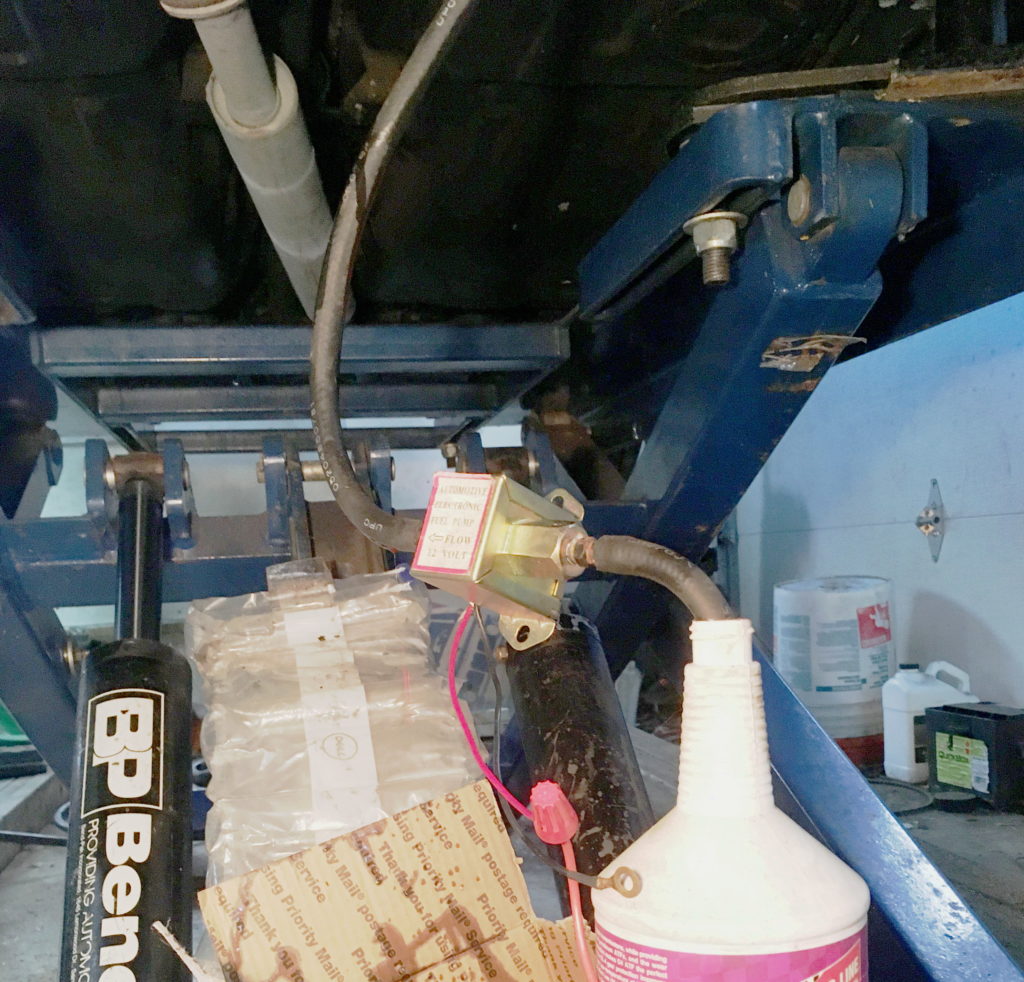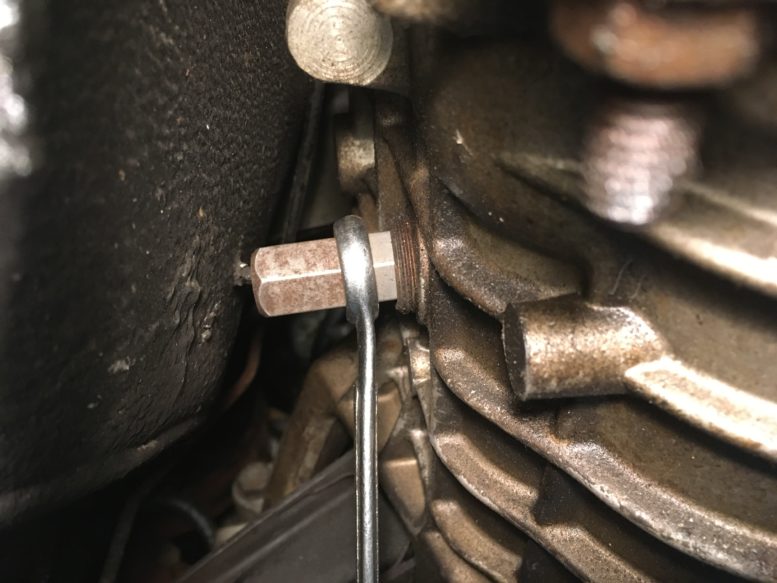After addressing the, er, hose-clamp situation on Hampton, the 48,000-mile ’73 2002 that I hope to sell this spring, there were just a few more items left on the punch list. The first was the clutch hydraulic line, because last June, when I replaced Hampton’s clutch master and slave cylinders, I found the clutch hose leaking.
The 2002’s original clutch hose was made of a translucent white plastic that yellows with age, but the “Genuine BMW” OE replacement that you’d get if you ordered it from a dealer is black plastic instead. This might not sound like a big deal—and in a societal sense, it certainly isn’t—but it costs around $140. For that kind of bread, it should at least look right. I wrote about how at the time I found a used hose on eBay for $50 but couldn’t bring myself to spend the money on a 47-year-old plastic hose, and instead bought a $28 off-brand (EPC) clutch hose.
It worked fine—but as I’ve spent time setting other things right with the car, the non-original hose bothered me a surprising amount.
So back to eBay I went. The used hose—or one priced just like it—was still available; with taxes and shipping it came to $62. I was about to click “Buy It Now” when I saw the no-return policy. I messaged the seller asking if he’d at least guarantee it against leaking after installation and a test drive. His response: “Well, I’m not going to say it’s ‘known good,’ but would guarantee it only to leak from end to end. Some people have been known to take cross-country ‘test drives,’ so I’m a bit wary of that terminology. And a Forever Warranty would require installation for intended purposes according to BMW specifications and procedures, not just some… HACK job!” We traded a few good-natured barbs, I installed the hose, it works fine, and the corner of my mind that seems to be increasingly concerned about Hampton’s originality can sleep a little better at night.

The incorrect rubber clutch hose, and the correct (though used) yellowed plastic one.

Done. Now\, no one on BaT can nitpick about it. That alone is probably worth the 62 bucks.
The next task was changing the fluids in the transmission and differential. On the one hand, I’m not about to road-trip this car anywhere, and with its low mileage, it’s questionable whether the next owner will, either; but from a marketing standpoint, it’s good to say “all fluids changed,” and all means all.
Differentials and manual transmissions don’t have a dipstick with which you can check their fluid level. They are filled by pumping in fluid until it leaks out of the fill hole. So while you could undo the fill hole and stick your finger in it to see if the fluid level is just below the threads, and if it’s not, top it off, you don’t know what kind of fluid is in there—so from a practical standpoint, it’s best to drain, refill, and be done with it.
The last time I changed driveline fluid was on Bertha the 2002 during her resurrection from her 26-year-long slumber. Bertha’s diff was a bit noisy, and even using a MAPP-gas torch, I could not loosen the fill plug for love nor money; in fact, the Allen recess in the fill plug eventually stripped. I wound up having to pull out the differential and swap in another one. A post-mortem revealed that the diff had no fluid in it. This provides a nice example of why a differential and transmission-fluid change should be part of the sort-out of a newly-acquired car.
I’ve used Red Line fluids for decades: 75W90 for the differential and MTL or ATF for the gearbox. The published capacities are 0.8 quarts for the differential and 1.2 quarts for the transmission. I checked in the garage and found a nearly-empty bottle of 75W90 (probably the remaining 0.2 quarts from my last fill) and two bottles of MTL, one full, the other nearly empty. I ordered one bottle of 75W90 and rolled the dice that I had about the right amount of MTL. And while I waited for the 75W90 for the diff to arrive, I started on the transmission.
With any driveline component that has a both a fill plug and a drain plug, it’s a good habit to always undo the fill plug first. That way, if you can’t get it out, at least you haven’t first emptied all of the fluid through the drain plug, with no way to get it back in short of turning the car upside down or removing the gearbox. But I had a bit of a conceptual disconnect when I saw that instead of the raised 17-mm nuts I’m used to seeing on the fill and drain plugs of 2002 four-speed transmissions, for some reason Hampton’s gearbox has recessed 17-mm Allen-key plugs, the kind you find on Getrag 245 five-speed gearboxes (yes, I’m certain Hampton doesn’t have a five-speed). I crawled under my back porch and looked at the two four-speeds and the one five-speed that are sitting under there, and confirmed that my memory was correct.

A short archaeological excavation confirmed that it wasn’t my imagination that 2002 four-speeds have protruding, not recesse,d drain and fill plugs.

A little Yankee ingenuity to the rescue.
No matter: I have both a 17-mm right-angle Allen key onto which I can slide a pipe for leverage and a 17-mm Allen hex bit for a half-inch ratchet. I tried the right-angle Allen key first, and realized that there was a problem: There’s not enough clearance between the transmission tunnel and the gearbox to fit the 2-1/2″ short leg of the Allen key in the hole.
I then recalled having this same problem when I changed the fluid in the five-speed in Bertha two years ago. I recalled having cut a section off the long leg of a right-angle Allen key in order to make a little stub, and turning it with a 17-mm wrench. I looked at the long leg of the Allen key, and sure enough, I could see the marks where I’d cut the section off the end.
Okay, then, I thought, I made a tool, so I must’ve put it in the drawer in the big tool chest with the rest of the Allen wrenches. But to my stunned surprise, it was nowhere to be found.
Fortunately, I was able to take the 17-mm Allen hex socket, a hammer, and a drift, and pound the bit out of its half-inch socket. The bit was just short enough to clear the side of the transmission tunnel. With a wrench on it, I was able to get the fill plug out—and at that point I pulled the drain plug.
The draining part is easy, but filling the transmission and differential is a bit of a pain. There’s no easy way to get to it and gravity-feed it from above, so instead you need to pump the fluid in through the fill hole. I have one of those devices that’s essentially a foot-long hypodermic syringe with a hose on the end, but it really makes an awful mess: You have to insert the hose in the fluid bottle, pull back on the syringe to fill its chamber, withdraw the hose from the bottle, stick the hose in the fill port, pump the fluid in, and repeat until the box is full—and while you’re doing this, fluid tends to drip everywhere with each transfer.
I know that I once bought one of those little soap-dispenser-like pumps that screws directly to the top of a bottle of Red Line, but I couldn’t find it in the garage. And I recalled it not working very well and taking forever anyway.
So I tried something new.
I have a couple of spare low-pressure electric fuel pumps, the little square solenoid-style units that replace a mechanical pump on a carbureted car. I pressed one into service for driveline-refilling duty by putting some hoses onto the inlet and outlet ports of pump, one to reach the bottom of the fluid bottle, the other to reach up to the fill port. Then, using a set of alligator clamps and long wires, I connected the clamps to the car’s battery, twisted the positive wire in place with a wire nut, and held the two negative wires together as a manual on-off switch.
I pumped the first bottle of MTL into the transmission until I heard the pump suck the bottle dry. Then I switched to the almost-empty second bottle, and smiled as two events occurred nearly simultaneously: seeing the first drips of fluid flow out the fill port and hearing the pump suck the bottle dry.

This worked like a charm. Sometimes it is good to be lazy.
The differential was refilled the same way. Fortunately, there were no surprises with its stock 12-mm Allen-head fill and drain plugs.
Changing driveline fluids gives me an odd sense of satisfaction. It’s messy, and the smell of original, never-been-changed fluid is pretty pungent, but it’s such a characteristic smell that it takes me straight back to doing this for the first time on a 2002 in the carport of our apartment at the intersection of Speedway and West 35th Street in Austin 39 years ago. It’s not going to make the car run any better or go any faster, but I feel better knowing that I’ve provided the car with this bit of care. Sort of like making the kids eat their vegetables.—Rob Siegel
Rob’s latest book, The Lotus Chronicles: One man’s sordid tale of passion and madness resurrecting a 40-year-dead Lotus Europa Twin Cam Special, is now available here on Amazon. Signed copies of this and his other books can be ordered directly from Rob here.





















